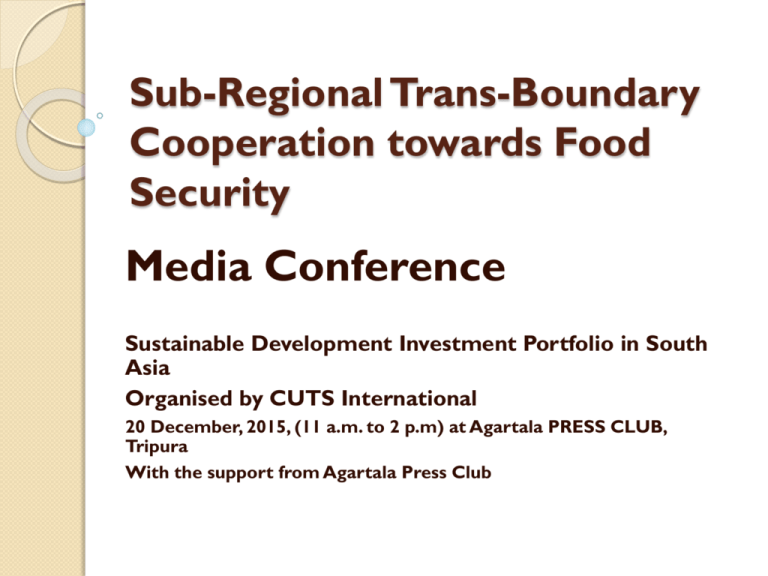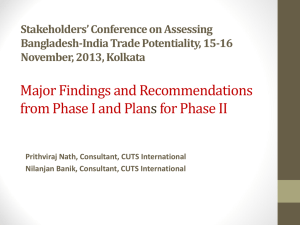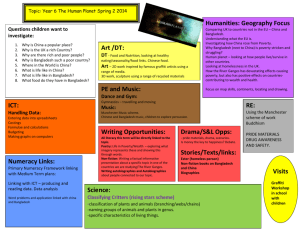Sub-Regional trans-boundary cooperation@ Ensuring Food Security
advertisement

Sub-Regional Trans-Boundary Cooperation towards Food Security Media Conference Sustainable Development Investment Portfolio in South Asia Organised by CUTS International 20 December, 2015, (11 a.m. to 2 p.m) at Agartala PRESS CLUB, Tripura With the support from Agartala Press Club Recent positive developments in Eastern South Asia and North East India Bangladesh-Bhutan-India-Nepal (BBIN) showing high political will for integration As many as 22 agreements, MoUs and protocols were agreed and signed during Indian Prime Minister’s visit to Dhaka in June 2015. This includes: ◦ Protocol for Exchange of Instrument of Ratification for Land Boundary Agreement ◦ Agreement on Coastal Shipping between India and Bangladesh ◦ Agreement on Kolkata-Dhaka- Agartala Bus Service ◦ Protocol on Inland Waterways Transit and Trade (PIWTT) ◦ MoU between India and Bangladesh on Use of Chittagong and Mongla Ports for Movement of Goods to and from India ◦ Bilateral Cooperation Agreement between Bureau of Indian Standard (BIS) and Bangladesh Standard and Testing Institute (BSTI) Recent positive developments in Eastern South Asia and North East India BBIN Motor Vehicle Agreement was inked by the four countries and protocols almost finalised India-Bangladesh already proposed furthering the existing energy cooperation Bangladesh agreed to give India exclusive access to two SEZs in Bheramara and Mongla Kaladan Multi-Modal Transit Transport Project expected to be completed in 2016 Rs 20,000-crore road projects declared by Indian Government, besides developing inland waterways, in the North-East Four Border Haats operating, many more planned BBIN Proposed Routes SEZs allocated to India Larger Connectivity Initiatives Tripura Surrounded Bangladesh, border Similarities in language, culture, climate and food habits High possible gains from cross border value chains (particularly agriproducts) 84% by of Tripura & Food Security While average outside procurement for paddy is 1 lakh metric tons, the same for vegetables was 0.13 lakh metric tons in 2012-13 and for Potato was roughly 1.3 lakh metric tons in 2013-14 With increasing population, this requirement is expected to increase in future with possible impact on food security 2014-2015 2015-2016 Ppn. Reqmnt. (Lakh) Metric Tons) 38.352 (Lakh Ppn. Veg Fruits 6.999 1.399 38.916 2016-2017 Reqmnt. Ppn. Veg Fruits 7.102 1.420 39.488 Reqmnt. Veg Fruits 7.206 1.441 Tripura shares 84% border with Bangladesh and is very similar in terms of climate, culture, language and most importantly food habits. Tripura and North Eastern states in general stand to gain from greater transboundary cooperation with Bangladesh and can have immediate gains from cross border agricultural value chains. Tripura & International Trade Tripura’s import from Bangladesh was INR 357 crores, (stone chips, cement, plastics products and fish) in 2014-15. The state can gain further from import of agricultural and other allied products. (data source: Department of Industries & Commerce, Government of Tripura) The export figure is comparatively low and includes seasonal fruits, cardboard, leather, etc. The state has potential to enhance its exports in rubber, betel leaf, bay leaf, etc. Import Export 1.71 329.05 1.55 255.84 1.02 0.41 0.41 Export 357.65 342.65 229.83 Import Border Haats – A Success Story A very good initiative by the state are the two existing Border Haats with Bangladesh operating at Srinagar and Kamalasagar. The haats are doing really well in terms of generating local economic benefits as well as access to new and better products. Collective business at the borer haats have crossed INR 2 crores so far for the current year. CUTS’s study of the haats also revealed that the haats stand as live examples of how trans-boundary cooperation can lead to immediate economic gains, higher access and better people-to-people connect. Hurdles Regulatory Barriers, (e.g. quarantine regulations) and lack of cooperation between national authorities Non-harmonised standards and non-recognition of certificates Lack of adequate testing facilities Institutional and Stakeholder Capacity Local political ownership of initiatives Infrastructure Way outs Promote higher cooperation between state, national and transboundary regulatory authorities Promote harmonisation and mutual recognition of standards and certifications Facilitate a more robust trans-boundary agricultural value chain Build capacities of stakeholders and institutions Create ownership of developmental projects Upgrade infrastructure Promote Border Haats Role of Media Enhance capacity on trade led development issues, the hurdles and possible solutions Create space for public and policy level discourses on these issues, particularly for trans-boundary cooperation in the TripuraBangladesh perspective Create public and political consensus on the need to promote pro-people and procooperation policy and practice change We Welcome Your Opinions and Deliberations Thank You Prithviraj Nath Policy Analyst & Head Cuts Calcutta Resource Centre +919830481370 pn@cuts.org





